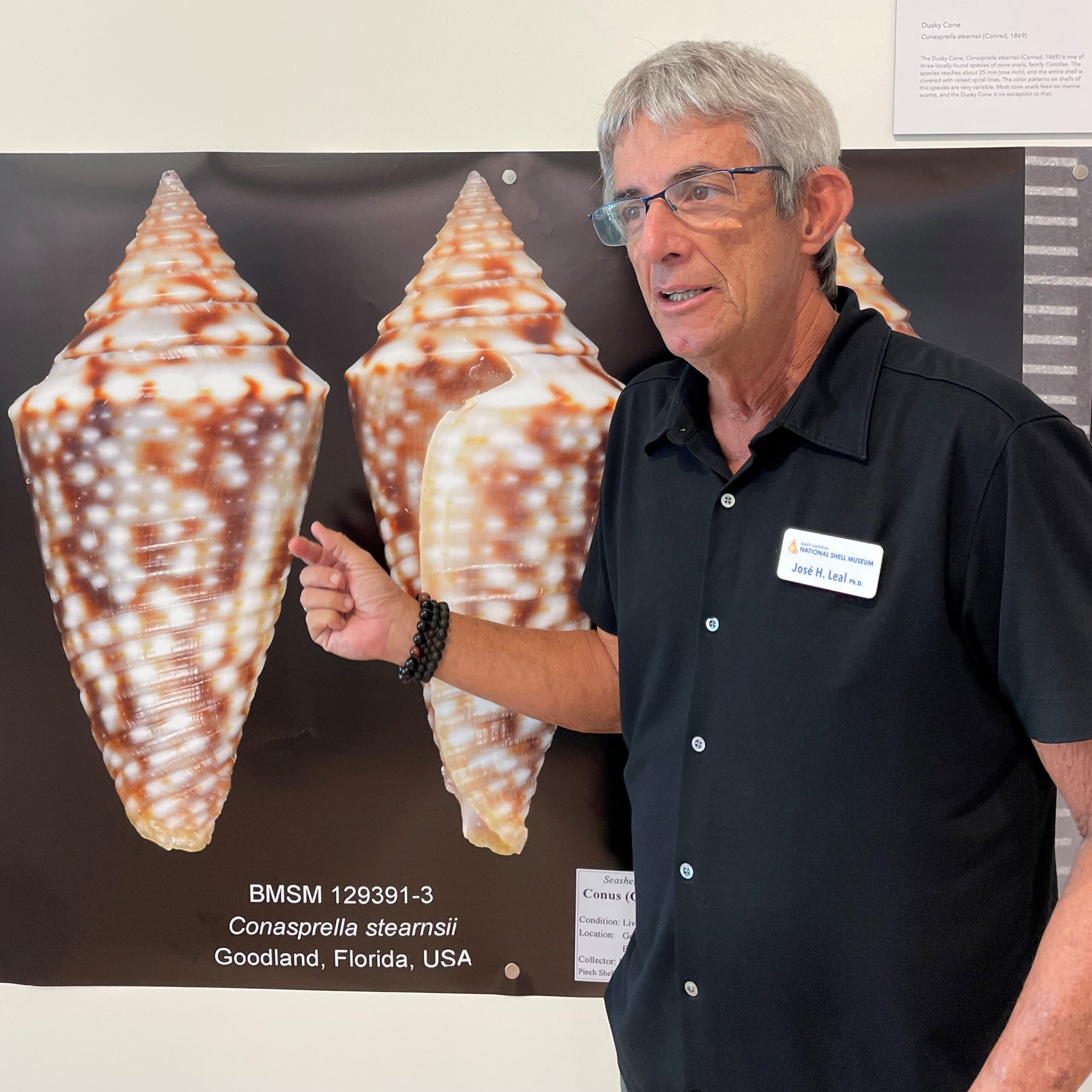Lectures

Archive of Online Lectures
October 16, 2025—Gulf Seafood: Sustaining Wildlife and Our Way of Life. By John Fallon, Director of Sustainability and Conservation Initiatives at the Audubon Nature Institute. Watch recording >>
September 18, 2025— What Can Oysters Tell Us About the Restoration of the Everglades? By Stephen Geiger, Ph.D., a Research Scientist studying Molluscan Fisheries/Marine Fisheries Biology at the Fish & Wildlife Research Institute of the Florida Fish & Wildlife Conservation Commission. Watch recording >>
August 21, 2025— South Florida’s Seasonal Seas. By Gabriel Jensen, photographer, biochemist, and photo-naturalist. Watch recording>>
July 24, 2025— Recent Research and Revelations at the Shell Museum & Aquarium. By Dr. José H. Leal, Science Director and Curator, and Jorden Falker, Associate Director of Education. Watch recording >>
Nov 14, 2024 — Carrier Shells: Nature’s Original Shell Collectors. By Gary Kidder, Collections Manager for Malacology and Inventory, Houston Museum of Natural Science. Watch recording >>
Sep 19, 2024 — Towards a New Great Hall of Shells. By José H. Leal, Ph.D., Science Director and Curator, Bailey-Matthews National Shell Museum & Aquarium and Sam Ankerson, Executive Director, Bailey-Matthews National Shell Museum & Aquarium. Watch recording >>
Aug 22, 2024 — Ecological and Historical Studies on Land Snails: Tiger Snails and Glacial History. By Dr. Timothy Pearce, Assistant Curator, Mollusks, Carnegie Museum of Natural History. Watch recording >>
Oct 12, 2023 — The Charisma of Cowries. Dr. José H. Leal, Ph.D., Science Director and Curator, Bailey-Matthews National Shell Museum. Watch recording >>
Sep 14, 2023 — Renewal: The Bailey-Matthews National Shell Museum One Year After Hurricane Ian. By Sam Ankerson, Executive Director, Bailey-Matthews National Shell Museum. Watch recording >>
Aug 17, 2023 — The Secret and Endangered Lives of Freshwater Mussels. By Dr. John Pfeiffer, Curator of Bivalvia, Smithsonian National Museum of Natural History. Watch recording >>
Jul 13, 2023 — Hawaiian Land Snails: Lessons in Conservation, Curation, and Research. By Dr. Norine Yeung, Malacology Curator, Bernice Pauahi Bishop Museum. Watch recording >>
May 17, 2023 — Micromollusks: The Allure of Small Size. By José H. Leal, Ph.D., Science Director and Curator, Bailey-Matthews National Shell Museum. Watch recording >>
Apr 20, 2023 — The Journey to One Billion Oysters with One Million New Yorkers. By Pete Malinowski, Executive Director of Billion Oyster Project. Watch
recording >>
Mar 23, 2023 — Exploring the Oceans for Public Television. By Alexa Elliott, Creator and Producer of PBS Program Changing Seas. Watch recording >>
Feb 15, 2023 — Renovating the George W. Strake Hall of Malacology, From Bottom to Top. By Tina Petway, Associate Curator of Malacology, Houston Museum of Natural Science. Watch recording >>
Jan 19, 2023 — Land Snails in Los Angeles: An Experiment in Urban Citizen Science. By Dr. Jann Elizabeth Vendetti, Associate Curator and Twila Bratcher Chair in Malacology Natural History Museum of Los Angeles County. Watch recording >>
Nov 10, 2022 — Hurricanes and Mollusks. By Dr. José H. Leal, Science Director and Curator Bailey-Matthews National Shell Museum. Watch recording >>
Sep 14, 2022 — Saving the Queen of the Sea: Queen Conch Conservation Aquaculture. By Megan Davis, Ph.D., Research Professor, Aquaculture and Stock Enhancement Program Florida Atlantic University Harbor Branch Oceanographic Institute. Watch recording >>
Aug 11, 2022 — Mobilizing Millions of Mollusks of the Eastern Seaboard. By Rüdiger Bieler, PhD, Curator of Invertebrates Field Museum of Natural History; and José H. Leal, PhD, Science Director and Curator Bailey-Matthews National Shell Museum. Watch recording >>
Jul 13, 2022 — Let’s Get Kraken: Cephalopods Coast to Coast. By Bret Grasse, Manager of Cephalopod Operations Marine Biological Laboratories (Woods Hole, MA). Watch recording >>
Jun 16, 2022 — Spot the Mollusk! By Rebecca Mensch, Senior Marine Biologist Bailey-Matthews National Shell Museum. Watch recording >>
Oct 20, 2021 — Spooky Mollusks and Other Evils of the Deep: A Halloween Special. By José H. Leal, Ph.D., Science Director and Curator, Bailey-Matthews National Shell Museum. Watch recording >>
Sep 28, 2021 — Shell Dressed: Seashells in Fashion and Jewelry. By Jean M. Burks, Curator Emerita, Shelburne Museum, and Kory Rogers, Francie and John Downing Senior Curator of American Art, Shelburne Museum. Watch recording >>
Sep 16, 2021 — Why Am I Growing Giant Clams in the Middle of the Arizona Desert? By Dan Killam, Ph.D., Biosphere 2, University of Arizona. Watch recording >>
Aug 24, 2021 — 8,000 Years of Shells in the American Southeast: Archaeological Insights on the Ecology, Diet, Architecture, and Ritual of Ancient Native Americans. By Kenneth E. Sassaman, Hyatt and Cici Brown Professor of Florida Archaeology, University of Florida. Watch recording >>
Jul 27, 2021 — Supersized Squid. By Rebecca Mensch, Senior Marine Biologist, Bailey-Matthews National Shell Museum. Watch recording >>
Jul 13, 2021 — Oysters: A Crystal Ball for Water Quality in Southwest Florida. By Melissa A. May, Ph.D., Assistant Professor of Marine Biology, Florida Gulf Coast University. Watch recording >>
Jun 29, 2021 — Curator’s Choice: New Photographs of Extraordinary Shells, and the Digital Imaging Project at the National Shell Museum. By José H. Leal, Ph.D., Science Director and Curator, Bailey-Matthews National Shell Museum. Watch recording >>
Jun 15, 2021 — Artistic Adaptations: 2,000 Years of Seashells in Art. By Jean M. Burks, Curator Emerita, Shelburne Museum, and Kory Rogers, Francie and John Downing Senior Curator of American Art, Shelburne Museum. Watch recording >>